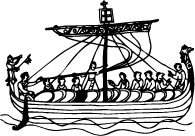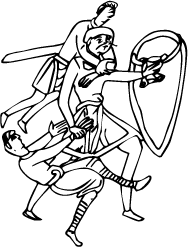The Font or the Tale
Fred Showker
 When the Bayeux font was first downloaded, it presented an intriguing puzzle. Who made it and why? There are actually three versions of the font, each with a collection of real and mythical figures of all manner of war, death and destruction. Many of the characters are engaged in combat, or dead, or in various stages of death. There are also knights, archers, ships, lords and ladies -- making this font one of the fun fonts for your collection. With a little research we discovered the font is actually a collection of characters found on the Bayeux Tapestry.
When the Bayeux font was first downloaded, it presented an intriguing puzzle. Who made it and why? There are actually three versions of the font, each with a collection of real and mythical figures of all manner of war, death and destruction. Many of the characters are engaged in combat, or dead, or in various stages of death. There are also knights, archers, ships, lords and ladies -- making this font one of the fun fonts for your collection. With a little research we discovered the font is actually a collection of characters found on the Bayeux Tapestry.
The Original Bayeux Tapestry
 The Bayeux Tapestry is the most important historical document from the period of 1066 and the Battle of Hastings. Today, the Bayeux Tapestry is preserved and displayed in Bayeux, in Normandy, France. Nothing is known for certain about the tapestry's origins. The first written record of the Bayeux Tapestry is in 1476 when it was recorded in the cathedral treasury at Bayeux as "a very long and narrow hanging on which are embroidered figures and inscriptions comprising a representation of the conquest of England". The 'tapestry' depects 623 humans, 55 canines, 202 equines, 41 ships, 49 trees, Almost 2000 Latin words, Over 500 mythical and non mythical creatures such as birds and dragons. At least 8 colours of yarn are discernible. Here, you will find the complete Bayeux Tapestry reproduced section by section in fairly good image files for the web.
The Bayeux Tapestry is the most important historical document from the period of 1066 and the Battle of Hastings. Today, the Bayeux Tapestry is preserved and displayed in Bayeux, in Normandy, France. Nothing is known for certain about the tapestry's origins. The first written record of the Bayeux Tapestry is in 1476 when it was recorded in the cathedral treasury at Bayeux as "a very long and narrow hanging on which are embroidered figures and inscriptions comprising a representation of the conquest of England". The 'tapestry' depects 623 humans, 55 canines, 202 equines, 41 ships, 49 trees, Almost 2000 Latin words, Over 500 mythical and non mythical creatures such as birds and dragons. At least 8 colours of yarn are discernible. Here, you will find the complete Bayeux Tapestry reproduced section by section in fairly good image files for the web.
 The history of the Bayeux Tapestry is nicely presented, along with many graphics and interpretations at www.bayeuxtapestry.org.uk. There, you can read the tale told by the Bayeux Tapestry - the story of William the Conqueror and Harold, Earl of Wessex, the men who led the Norman and Saxon armies in 1066. William's defeat of Harold at the Battle of Hastings ensured the success of the Norman invasion of England. Read the entire table of contents, complete with links to the specific entries.
The history of the Bayeux Tapestry is nicely presented, along with many graphics and interpretations at www.bayeuxtapestry.org.uk. There, you can read the tale told by the Bayeux Tapestry - the story of William the Conqueror and Harold, Earl of Wessex, the men who led the Norman and Saxon armies in 1066. William's defeat of Harold at the Battle of Hastings ensured the success of the Norman invasion of England. Read the entire table of contents, complete with links to the specific entries.
In 1993 a new Bayeux Tapestry gallery was opened in the Museum of Reading. The tapestry was carefully conserved and remounted as a continuous strip in a specially designed display case. For the first time for many years the entire tapestry could be seen in one gallery.
It seems the stories told by the tapestry have become a popular topic for web sites. We even ran across a site called the "Historic Tale Construction Kit" with an SWF game allows you to build your own tapestry. You can also enjoy the transcripts from the "Bayeux Tapestry Lecture" presented by Lynn Harry Nelson, Emeritus Professor of Medieval History, at the University of Kansas. On your tour, also enjoy the tapestry images compiled by Glen Ray Crack in his 1998 web site dedicated to the Battle - East Sussex - United Kingdom -- and follow along with the story of The Death and Burial of Edward the Confessor at the Eye Witness To History web site. If you want more, Google will be more than happy to render no less than seven-hundred-thousand references to the term "Bayeux" ... so have fun. But what you really came here for is the Bayeux Font...
The Bayeux Font
 Just like the tapestry, we know very little about the Bayeux Font. The archived copy contains dozens of characters taken from the Tapestry and converted into a digital outline font -- many of which adorn this page. Since there was no "read me" file included in the original download from AOL's font library, we have no idea who actually created the font.
Just like the tapestry, we know very little about the Bayeux Font. The archived copy contains dozens of characters taken from the Tapestry and converted into a digital outline font -- many of which adorn this page. Since there was no "read me" file included in the original download from AOL's font library, we have no idea who actually created the font.
* Here's a font sample of the Bas Bayeux Font.
* Here's a sample of the 2nd Volume of the Bas Bayeux Font.
You can download all three volumes of Bas Bayeux Font in our Publishers' Warehouse.
Corrections & a reader comments...
We always love to hear from readers, and we thank Rosemary Chapman in London who recently wrote with these corrections and an undiscovered font...
Rosemary writes:
Your Bayeux tapestry item in the paragraph is rather misleading you state that..
'In 1993 a new Bayeux Tapestry gallery was opened in
the Museum of Reading. The tapestry was carefully
conserved and remounted as a continuous strip in a
specially designed display case.
 This actually relates to the 'Reading Bayeux Tapistry' which was a copy made in the Victorian period around about 1885. your link http://www.bayeuxtapestry.org.uk also relates to this copy rather than the original.
This actually relates to the 'Reading Bayeux Tapistry' which was a copy made in the Victorian period around about 1885. your link http://www.bayeuxtapestry.org.uk also relates to this copy rather than the original.
At Freeware Fonts by Nikos Goulandris this unusual collection of fonts with a historical flavour may help you tracking the origins of basBayeux. You might also be interested in the font KING HAROLD which is based on the lettering from the tapistry .
Hope this is helpful!
Thank you Rosemary -- it sure was helpful, and we discovered new fonts at the same time!
At Harold's Fonts you can sift through hundreds of free fonts including 'King Harold', which was inspired by the embroidered lettering on the famous Bayeux Tapestry. (DL: Win Font, or Mac Font)
We welcome your questions or comments on this article as well as your favorite font discoveries!
Return to the Fonts Festival
Return to the Type Department, or back out to the Design Center front page
- Questions or comments on this article?
- DISCUSS THIS IN the Designers' CAFE forums





